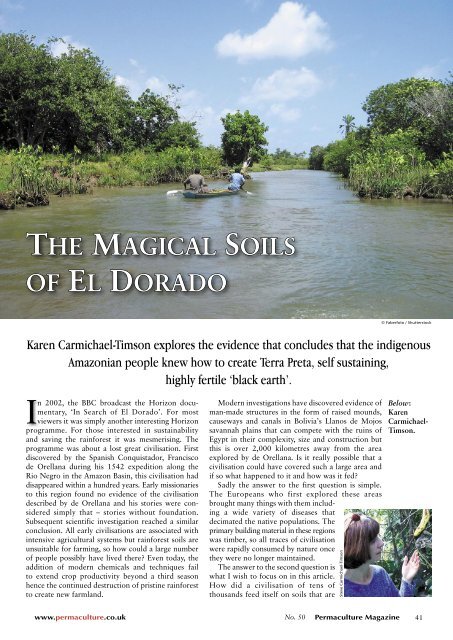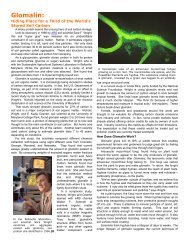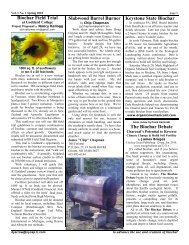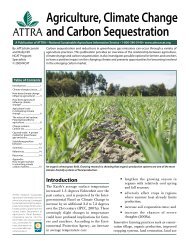Carmichael-Timson
Article on Terra Preta (.pdf) - Department of Crop and Soil Sciences
Article on Terra Preta (.pdf) - Department of Crop and Soil Sciences
- No tags were found...
You also want an ePaper? Increase the reach of your titles
YUMPU automatically turns print PDFs into web optimized ePapers that Google loves.
THE MAGICAL SOILS<br />
OF EL DORADO<br />
© Faberfoto / Shutterstock<br />
Karen <strong>Carmichael</strong>-<strong>Timson</strong> explores the evidence that concludes that the indigenous<br />
Amazonian people knew how to create Terra Preta, self sustaining,<br />
highly fertile ‘black earth’.<br />
In 2002, the BBC broadcast the Horizon documentary,<br />
‘In Search of El Dorado’. For most<br />
viewers it was simply another interesting Horizon<br />
programme. For those interested in sustainability<br />
and saving the rainforest it was mesmerising. The<br />
programme was about a lost great civilisation. First<br />
discovered by the Spanish Conquistador, Francisco<br />
de Orellana during his 1542 expedition along the<br />
Rio Negro in the Amazon Basin, this civilisation had<br />
disappeared within a hundred years. Early missionaries<br />
to this region found no evidence of the civilisation<br />
described by de Orellana and his stories were considered<br />
simply that – stories without foundation.<br />
Subsequent scientific investigation reached a similar<br />
conclusion. All early civilisations are associated with<br />
intensive agricultural systems but rainforest soils are<br />
unsuitable for farming, so how could a large number<br />
of people possibly have lived there? Even today, the<br />
addition of modern chemicals and techniques fail<br />
to extend crop productivity beyond a third season<br />
hence the continued destruction of pristine rainforest<br />
to create new farmland.<br />
Modern investigations have discovered evidence of<br />
man-made structures in the form of raised mounds,<br />
causeways and canals in Bolivia’s Llanos de Mojos<br />
savannah plains that can compete with the ruins of<br />
Egypt in their complexity, size and construction but<br />
this is over 2,000 kilometres away from the area<br />
explored by de Orellana. Is it really possible that a<br />
civilisation could have covered such a large area and<br />
if so what happened to it and how was it fed?<br />
Sadly the answer to the first question is simple.<br />
The Europeans who first explored these areas<br />
brought many things with them including<br />
a wide variety of diseases that<br />
decimated the native populations. The<br />
primary building material in these regions<br />
was timber, so all traces of civilisation<br />
were rapidly consumed by nature once<br />
they were no longer maintained.<br />
The answer to the second question is<br />
what I wish to focus on in this article.<br />
How did a civilisation of tens of<br />
thousands feed itself on soils that are<br />
Steve <strong>Carmichael</strong>-<strong>Timson</strong><br />
Below:<br />
Karen<br />
<strong>Carmichael</strong>-<br />
<strong>Timson</strong>.<br />
www.permaculture.co.uk No. 50 Permaculture Magazine 41
Above:<br />
It’s easy to<br />
see how<br />
Terra Preta<br />
soil can lie<br />
undiscovered<br />
in the Amazon<br />
rain forest.<br />
Right:<br />
Scientific<br />
equipment<br />
monitoring<br />
the carbon<br />
dioxide<br />
losses from<br />
Terra Preta<br />
de Indio<br />
near Manaus,<br />
Brazil.<br />
Experiments<br />
show the<br />
great stability<br />
of the organic<br />
matter in<br />
these Dark<br />
Earth soils.<br />
naturally thin, nutrient starved, subjected to intensive<br />
rainfall and contained high concentrations of aluminium?<br />
The answer is an almost magical soil called Terra Preta<br />
(de Indio). I say magical because not only are these soils<br />
extremely fertile but the fertility is maintained for<br />
hundreds of years. The aluminium levels are reduced<br />
and the heavy rains does not wash away the nutrients.<br />
INDIAN BLACK EARTH<br />
So what is Terra Preta? Where will you find it and how<br />
did it get there? The answer is quite simple. Terra Preta<br />
is an anthrosol (or anthropogenic) soil. These Indian<br />
Black Earth soils are found throughout Amazonia.<br />
They are man-made soils created by the indigenous<br />
Indian population and are now known to have existed<br />
for over 2,000 years.<br />
These soils were supporting complex societies at<br />
least 1,000 years before contact with Europeans in<br />
1542 occurred. De Orellana described native villages<br />
that stretched many miles along river bluffs with<br />
roadways linking to settlements in the interior. This is<br />
where the Terra Preta soils have been found.<br />
The Amazonian upland soils (Terra Firme) are<br />
highly weathered and very acidic. They have few<br />
nutrients and very high aluminium concentrations.<br />
They are not suitable for productive agriculture. The<br />
várzea (flood plains) soils, although better suited to<br />
crop production, suffer from unpredictable floods.<br />
Terra Preta is a strongly weathered soil with a thick<br />
humus layer – the dark loam is created by the addition<br />
of biological matter. The richest, blackest (Terra Preta<br />
de Indio) soils are found above former village middens<br />
or rubbish tips whilst the lighter, dark brown form<br />
Terra Mulata is believed to be the result of intensive<br />
cultivation practices – its high black carbon particle<br />
content being derived from the slash and char techniques<br />
of the native pre-European inhabitants of the area.<br />
These soils are also known to contain large quantities of<br />
pottery shards that also pre-date the European incursions.<br />
Indian Dark Earth soils are known for their high<br />
fertility and sustainability. They contain high levels<br />
© Johnny Lye / Shutterstock<br />
© Johannes Lehmann<br />
of nutrients, soil bacteria, charcoal and arbuscular<br />
mycorrhizal fungi unique to this region. The soils were<br />
enriched with potassium, phosphorus and calcium from<br />
the food waste thrown onto the village middens – fish<br />
and animal bones, shells, manure (human or animal) etc.<br />
The slash and char method of clearing land uses the<br />
same amount of biomass as in a slash and burn approach<br />
but the slash and char method retains approximately<br />
50% of the biomass as black charcoal which is added to<br />
the soil. The charcoal produced by this technique is the<br />
same as any other charcoal – there is nothing special about<br />
it. However, charcoal acts as a sponge which absorbs<br />
nutrients and enables the soils to retain nutrients that<br />
would otherwise be washed out by the high rainfall levels.<br />
Furthermore, the high concentrations of aluminium are<br />
neutralised by the charcoal. The University of Bayreuth<br />
in Germany has been carrying out field trials in the<br />
Amazon basin and have found that the addition of charcoal<br />
increases soil fertility by a staggering 880%.<br />
The heightened fertility of these soils has been<br />
recognised by indigenous inhabitants and current<br />
colonists. Original Terra Preta soil is ‘mined’ and sold<br />
by local farmers. It is used as a starter to generate new<br />
Terra Preta soil. We cannot yet recreate the soils from<br />
new but we know the mycorrhizal fungi play a vital<br />
part in the regeneration process. Cornell University in<br />
the USA and the University of Bayreuth lead the way<br />
in researching these soils together with their partners<br />
at the National Amazonian Institution and the Museo<br />
Goeldi in Brazil.<br />
Chapter 4 of the United Nations World Reference<br />
Base for Soil Resources 2006 states: “Anthrosols<br />
comprise soils that have been modified profoundly<br />
through human activities, such as addition of organic<br />
42 Permaculture Magazine No. 50 www.permaculture.co.uk
materials or household wastes, irrigation and cultivation.<br />
This group includes soils otherwise known as:<br />
Plaggen soils, Paddy soils, Oasis soils, Terra Preta do<br />
Indio (Brazil), Agrozems (Russian Federation), Terrestrische<br />
anthropogene Böden (Germany), Anthroposols<br />
(Australia) and Anthrosols (China).” And:<br />
“Anthrosols are found wherever people have practised<br />
agriculture for a long time.”<br />
Those agricultural societies that have not adopted<br />
modern unsustainable farming methods and still<br />
maintain their soils in their traditional ways are<br />
producing anthrosols with properties similar to the<br />
Indian Dark Earths. If you are making compost you<br />
are making an anthrosol.<br />
CAN SOIL SAVE HUMANITY?<br />
So what are the benefits? Well the most obvious one<br />
is that instead of using a slash and burn technique to<br />
destroy more and more rainforest, the slash and char<br />
technique combined with a planned cycle of resting<br />
allows the same area to be used indefinitely. Not only<br />
can large quantities of crops be grown but habitat is<br />
maintained for the benefit of all. A sensible approach<br />
to ‘mining’ this resource could spread its advantages<br />
throughout South America and possibly beyond.<br />
Cornell University has suggested that the biomass<br />
could also be used to produce clean energy. Their Terra<br />
Preta Science Brief states: “Agricultural wastes as well<br />
as bioenergy crops can be used to produce energy by<br />
burning them in specialized power plants and yield<br />
black carbon as a by-product. The majority of the<br />
energy is converted into hydrogen. Due to favourable<br />
energetic processes, the efficiency of the energy production<br />
is very large while carbon retention is high due<br />
L. Dathe © Johannes Lehmann<br />
to additional stripping of emissions in the flue gas. This<br />
is a revolutionary process by which energy production<br />
can become a net sink of atmospheric carbon dioxide<br />
and provide organic matter to enrich our soils.”<br />
So there we have it. Terra Preta soils are highly<br />
fertile and last for millennia; they could also save the<br />
rainforest, generate abundant clean energy and reduce<br />
carbon emissions.<br />
Should we transfer Terra Preta elsewhere in the<br />
world? As shown above, anthrosol soils already exist<br />
throughout the world. It is the addition of black carbon<br />
in the form of charcoal that makes such a difference<br />
in the Amazon. We already reclaim depleted soils<br />
on brown-field sites by seeding them with bacteria<br />
and mycorrhizal fungi from a nearby natural source.<br />
We can compost all suitable wastes and add charcoal<br />
(and volcanic rock dust as found in Andosol soils) to<br />
increase fertility and nutrient levels.<br />
It is not the soil itself that needs to be exported; it is<br />
the techniques used to create it. What the Terra Preta<br />
story really tells us is that the future of humanity and<br />
this planet could well rest on us relearning what our<br />
ancestors once knew<br />
REFERENCES<br />
Amazonian Dark Earths – Origin, Properties, Management;<br />
Johannes Lehmann, Dirse Kern, Bruno Glaser<br />
and William I Woods; Kluwer AC Publ., 2003.<br />
Amazonian Dark Earths – Explorations in Space and<br />
Time; Bruno Glaser and William I Woods; University<br />
of Bayreuth.<br />
Cornell University Soil Biogeochemistry Program<br />
Science Brief, ‘Terra Preta: Soil Improvement and<br />
Carbon Sequestration’, Johannes Lehmann.<br />
BBC Horizon Documentary ‘The Secret of El Dorado’.<br />
WEBSITES<br />
www.css.cornell.edu/faculty/lehmann/terra_preta/<br />
TerraPretahome.htm<br />
www.bbc.co.uk/science/horizon/2002/eldorado.shtml<br />
www.geo.uni-bayreuth.de/bodenkunde/terra_preta/<br />
www.fao.org/ag/agL/agll/wrb/doc/wrb2006final.pdf<br />
Karen <strong>Carmichael</strong>-<strong>Timson</strong> lives on a recently acquired<br />
smallholding in south west Wales with her maritime<br />
archaeologist (underwater cameraman) husband and<br />
three cats.<br />
DO YOU KNOW SOMETHING<br />
WE DON’T KNOW?<br />
Left:<br />
Johannes<br />
Lehmann<br />
(Cornell<br />
University)<br />
measuring<br />
the carbon<br />
chemistry of<br />
Dark Earth<br />
soils using<br />
X-ray technology<br />
at the<br />
National<br />
Synchrotron<br />
Light Source,<br />
USA. These<br />
measurements<br />
reveal the<br />
mechanisms<br />
causing the<br />
high fertility<br />
of Terra Preta<br />
de Indio.<br />
This article was kindly submitted after a request by Pat Browne<br />
on the PM49 Letters page for more information on Terra Preta<br />
(and thanks to all the readers who wrote in with further information).<br />
Are you searching for more facts on an elusive subject that<br />
could change the world?! Please write or email in with as many<br />
details as possible and we will ask our wonderful readers all over<br />
the world for further information or contacts. Ed<br />
www.permaculture.co.uk No. 50 Permaculture Magazine 43





